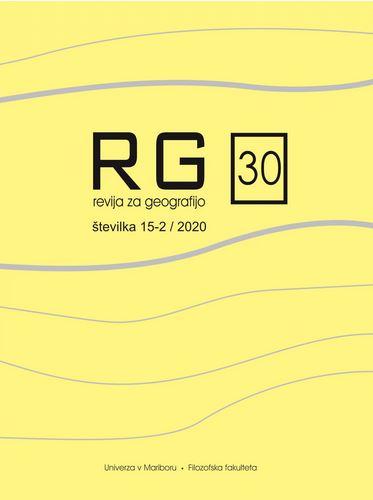Annual dynamics of the UHI phenomenon in a small urban system
DOI:
https://doi.org/10.18690/rg.15.2.3640Keywords:
Ljutomer, urban heat island, UHI, climate change, weather types, heat wavesAbstract
The urban heat island phenomenon (UHI) is a consequence of anthropogenic activity and local climatic conditions. Most UHI studies address large metropolitan areas. However, the data show that UHI magnitude can reach high values even in small urban systems. The study focused on the seasonal dynamics of the UHI magnitude variable (average, maximum and minimum temperature anomaly) in the town of Ljutomer by considering different weather types. Under anticyclonic or advective air circulation pattern, predominantly in summer, UHI magnitude in Ljutomer can reach values comparable to midsize or large urban systems (up to 8°C). The results of such studies are of particular concern in regard to increasing frequency of heat waves as a consequence of climate change, which further increases the already present heat stress in cities all over the Globe.
Downloads
References
Al-Hatab, M., Samir, A. in Taha, L. 2017: Monitoring and assessment of urban heat islands over the southern region of Cairo Governoate, Egypt. EJRS. http://dx.doi.org/10.1016/j.ejrs.2017.08.008
Balazs, B., Unger, J., Gal, T., Sümeghy, Z., Geiger, J. in Szegedi, S. 2009: Simulation of the mean urban heat island using 2D surface parameters: empirical modelling, verification and extension. Meteorological Applications 16, 275–287. http://dx.doi.org/10.1002/met.116
Čadež, M. 1949: O pretvaranju energije u atmosferi: Sur la transformation de l'énergie dans l'atmosphère. Savezna uprava Hidrometeorološke službe pri Vladi FNRJ.
Evola, G., Gagliano, A., Fichera, A., Marletta, L., Martinico, F., Nocera, F. in Pagano, A. 2017: UHI effects and strategies to improve outdoor thermal comfort in dense and old neighborhoods. Energy Procedia 134, 629–701. http://dx.doi.org/10.1016/j.egypro.2017.09.589
Figuerola, P.I. in Mazzeo, N.A. 1998: Urban–rural temperature differences in Buenos Aires. International Journal of Climatology 18, 1709–1723. https://doi.org/10.1002/(SICI)1097-0088(199812)18:15%3C1709::AID-JOC338%3E3.0.CO;2-I
Frölicher, T. L., Fischer, E. M. in Gruber, N. 2018: Marine heatwaves under global warming. Nature 560(7718), 360-364. https://doi.org/10.1038/s41586-018-0383-9
Gedzelman, S.D., Austin, S., Cermak, R., Stefano, N., Partriage, S., Quesenberry, S. in Robinson, D.A. 2003: Mesoscale aspects of the urban heat island around New York City. Theoretical and Applied Climatology 75, 29–42. https://doi.org/10.1007/s00704-002-0724-2
Ivajnšic, D., Kaligaric, M. in Žiberna, I. 2014: Geographically weighted regression of the urban heat island of a small city. Applied Geography 53, 341–353. http://dx.doi.org/10.1016/j.apgeog.2014.07.001
Ivajnšič, D. in Žiberna, I. 2019: The effect of weather patterns on winter small city urban heat islands. Meteorological Applications 26(2), 195-203. https://doi.org/10.1002/met.1752
Johnson, G.T., Oke, T.R., Lyons, T.J., Steyn, D., Watson, I.D. in Voogt, J.A. 1991: Simulation of surface urban heat islands under “ideal” conditions at night—part I: Theory and tests against field data. Boundary-Layer Meteorology 56, 275–294.
Kartografska podlaga Google satelit. Pridobljeno s vtičnikom QuickMapServices QGIS, Map data ©2015 Google.
Kassomenos, P.A. in Katsoulis, B.D. 2006: Mesoscale and macroscale aspects of the morning urban heat island around Athens, Greece. Meteorology and Atmospheric Physics 94, 209–218. https://doi.org/10.1007/s00703-006-0191-x
Kidder, S.Q. in Essenwanger, O.M. 1995: The effect of clouds and wind on the difference in nocturnal cooling rates between urban and rural areas. Journal of Applied Meteorology 34, 2440–2448. https://doi.org/10.1175/1520-0450(1995)034%3C2440:TEOCAW%3E2.0.CO;2
Lee, Y.Y., Din, M.F.M., Ponraj, M., Noor, Z.Z., Kenzo, I. and Chelliapan, S. 2017: Overview of urban heat island (UHI) phenomenon towards human thermal comfort. Environmental Engineering in Management Journal 16(9), 2097–2112. http://dx.doi.org/10.30638/eemj.2017.217
Li, J. J., Wang, X. R., Wang, X. J., Ma, W. C. in Zhang, H. 2009: Remote sensing evaluation of urban heat island and its spatial pattern of the Shanghai metropolitan area, China. Ecological Complexity 6(4), 413-420. http://dx.doi.org/10.1016%2Fj.ecocom.2009.02.002
Medrežje 1: https://data.worldbank.org/, povzeto 20.12.2020
Mihalakakou, G., Flocas, H.A., Santamouris, M. in Helmis, C. 2002: Application of neural networks to the simulation of the heat island over Athens, Greece, using synoptic types as a predictor. Journal of Applied Meteorology, 41 519–527. https://doi.org/10.1175/1520-0450(2002)041%3C0519:AONNTT%3E2.0.CO;2
Montavez, J.P., Rodriguez, A. in Jimenez, J.I. 2000: A study of the urban heat island of Granada. International Journal of Climatology 20, 899–911. https://doi.org/10.1002/1097-0088(20000630)20:8%3C899::AID-JOC433%3E3.0.CO;2-I
Moreno-Garcia, M.C. 1994: Intensity and form of the urban heat island in Barcelona. International Journal of Climatology 14, 705–710. https://doi.org/10.1002/joc.3370140609
Morris, C.J.G. in Simmonds, I. 2000: Associations between varying magnitudes of the urban heat island and the synoptic climatology in Melbourne, Australia. International Journal of Climatology 20, 1931–1954. https://doi.org/10.1002/1097-0088(200012)20:15%3C1931::AID-JOC578%3E3.0.CO;2-D
Morris, C.J.G., Simmonds, I. in Plummer, N. 2001: Quantification of the influences of wind and cloud on the nocturnal urban heat island of a large city. Journal of Applied Meteorology 40, 169–182. https://doi.org/10.1175/1520-0450(2001)040%3C0169:QOTIOW%3E2.0.CO;2
Oke, T. R. 1982: The energetic basis of the urban heat island. Quarterly Journal of the Royal Meteorological Society 108(455), 1-24. https://doi.org/10.1002/qj.49710845502
Oke, T.R. in Fuggle, R.F. 1972: Comparison of urban/rural counter and net radiation at night. Boundary-Layer Meteorology 2(3), 290–308.
O’Malley, C., Piroozfar, P., Farr, E. R. in Pomponi, F. 2015: Urban Heat Island (UHI) mitigating strategies: A case-based comparative analysis. Sustainable Cities and Society 19, 222-235. https://doi.org/10.1016/j.scs.2015.05.009
R Development Core Team. 2008: R: A Language and Environment for Statistical Computing. Vienna: R Foundation for Statistical Computing, ISBN 3-900051-07-0. pridobljeno na: http://www.Rproject.org [Accessed 25th Januar 2021].
Rogan, J., Ziemer, M., Martin, D., Ratick, S., Cuba, N. in DeLauer, V. 2013: The impact of tree cover loss on land surface temperature: a case study of Central Massachusetts using Landsat thematic mapper thermal data. Applied Geography, 45, 49–57. https://doi.org/10.1016/j.apgeog.2013.07.004
Stull, R. B., 1988: An introduction to boundary layer meteorology. Dordrecht. Kluwer.
Zhang, H., Qi, Z.F., Ye, X.Y., Cai, Y.B., Ma, W.C. in Chen, M.N. 2013: Analysis of land use/land cover change, population shift, and their effects on spatiotemporal patterns of urban heat islands in metropolitan Shanghai, China. Applied Geography, 44, 121–133 http://dx.doi.org/10.1016/j.apgeog.2013.07.021
Downloads
Published
Issue
Section
License
Copyright (c) 2020 Nataša Pipenbaher, Danijel Ivajnšič, Igor Žiberna, Daša Donša, Mitja Kaligarič, Sonja Škornik, Lučka Kajfež Bogataj, Zalika Črepinšek, Veno Jaša Grujić

This work is licensed under a Creative Commons Attribution 4.0 International License.
